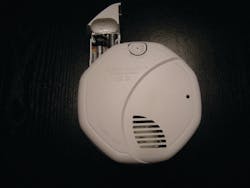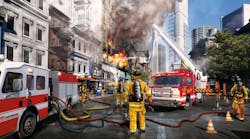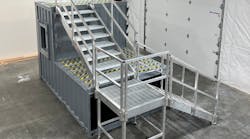If ever a tool was invented for the fire service that has saved countless lives, the undisputed champion has to be the smoke alarm.
The smoke alarms currently in use were introduced in the early 1970s. I remember my first smoke alarm cost about $50 and the battery it needed cost about $20 at a local hardware store. Now, smoke alarms can be bought for as little as $5 and the newer ones use two AA batteries that can be bought for approximately $1.
There are two types of smoke alarms – ionization and photoelectric. Without getting too technical and so you can easily explain it to the public so they understand, here is how they work.
Ionization smoke alarms
Ionization smoke alarms are the most common and have been in use the longest. Basically, people believe these devices “smell” smoke and set off an alarm. Actually, when combustion occurs, ions are released into the atmosphere. Ions from a fire enter a chamber in the smoke alarm, which contains a very small particle of radioactive material. An electronic reaction occurs in the chamber and that is what sets off the alarm.
Ions are not visible to the naked eye. That is why when you open an oven, the smoke alarm activates even though no smoke is visible. The ions that were contained in the oven from the cooking food were released into the atmosphere when the oven door was opened.
Ionization smoke alarms work well if ions are released during the combustion process, which is normally found in hot, fast-moving fires. During slower, cooler, smoldering incidents such as a cigarette butt stuffed in a couch and smoldering, ions are not readily released and the smoke alarm may not activate.
Photoelectric smoke alarms
Photoelectric smoke alarms contain a light chamber. When smoke enters the chamber, the beam of light is interrupted, causing the alarm to activate. This type of alarm works well with smoldering fires as described above.
Which type of alarm should a home have? Many organizations, including the U.S. Fire Administration (USFA), National Fire Protection Association (NFPA) and International Association of Fire Chiefs (IAFC), to name just a few, recommend that homes have BOTH types of alarms. This way, both types of fires are covered. A home can have separate units or a combination unit that has both sensors in the same smoke alarm. Alarms that are battery operated only as well as wired-in with battery backup are available. The box will display the letter I for ionization or P for photoelectric or both to indicate the type of smoke alarm it contains.
Ionization smoke alarms must be replaced every 10 years from the date stamped on the alarm. Because the radioactive particle is so small and decays daily, it will last approximately 10 years. If there is no particle, the smoke alarm will not work. After 10 years, I would suspect the light chamber in the photoelectric smoke alarm may contain dirt or dust, which could impair its operation.
Proper installation
Where should smoke alarms be installed? Residents should always follow the directions for installation included with a smoke alarm. One alarm should be placed in each room where a person sleeps, one in the hallway outside the sleeping areas and one just outside the kitchen toward the sleeping areas. If a home has more than one floor, there should be one alarm for each level.
Why? When you go to sleep, you lose your sense of smell. You will breathe deadly gases and carbon monoxide, which will put you in a deeper sleep and you will be overcome. Most fatal fires occur between the hours of 11 P.M. and 7 A.M., when people are sleeping.
Children will not wake to smoke alarms unless they are taught what they are and what they sound like. Children, from the time they are born until they are teens, are very deep sleepers. That is why it is important to practice “Exit Drills in the Home” (“E.D.I.T.H.”) and use an activated smoke alarm during the drill so children remember the sound, like they hear at school.
If the smoke alarm has a nine-volt battery or two AA batteries, they must be replaced once a year. Fire safety educators often teach people to change the batteries in the fall when they turn back clocks: “Change Your Clock, Change Your (Smoke Alarm) Battery.” Smoke alarms should be tested once a month to ensure they are operational.
Lastly, the devices are called “smoke alarms,” not “smoke detectors.” The most important thing to teach the public is this: Never go to sleep without a properly operating smoke alarm watching over you.






